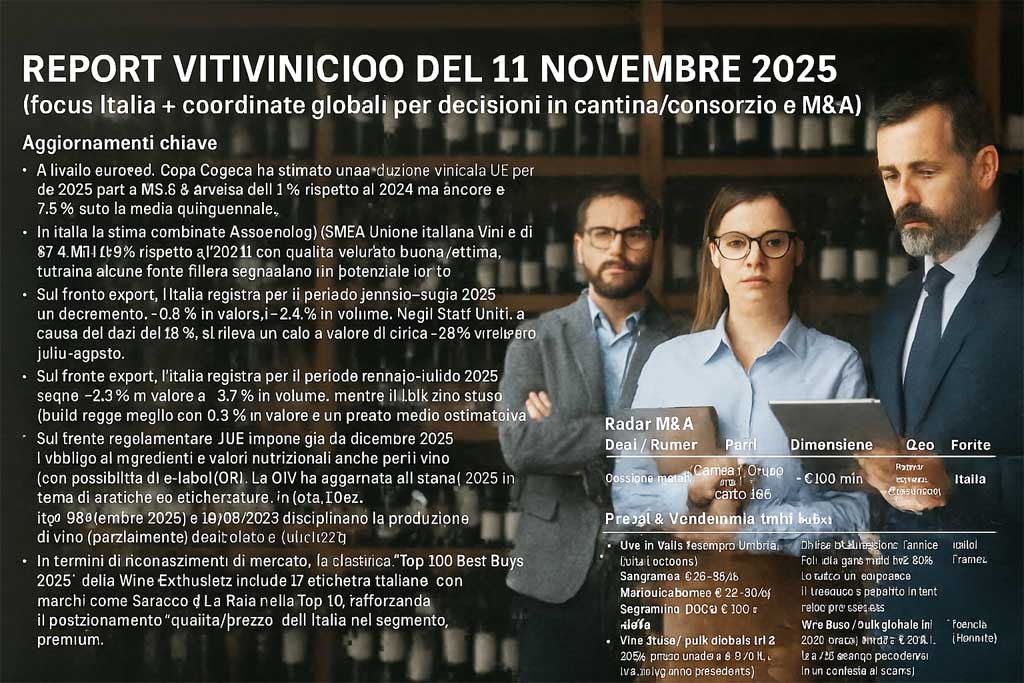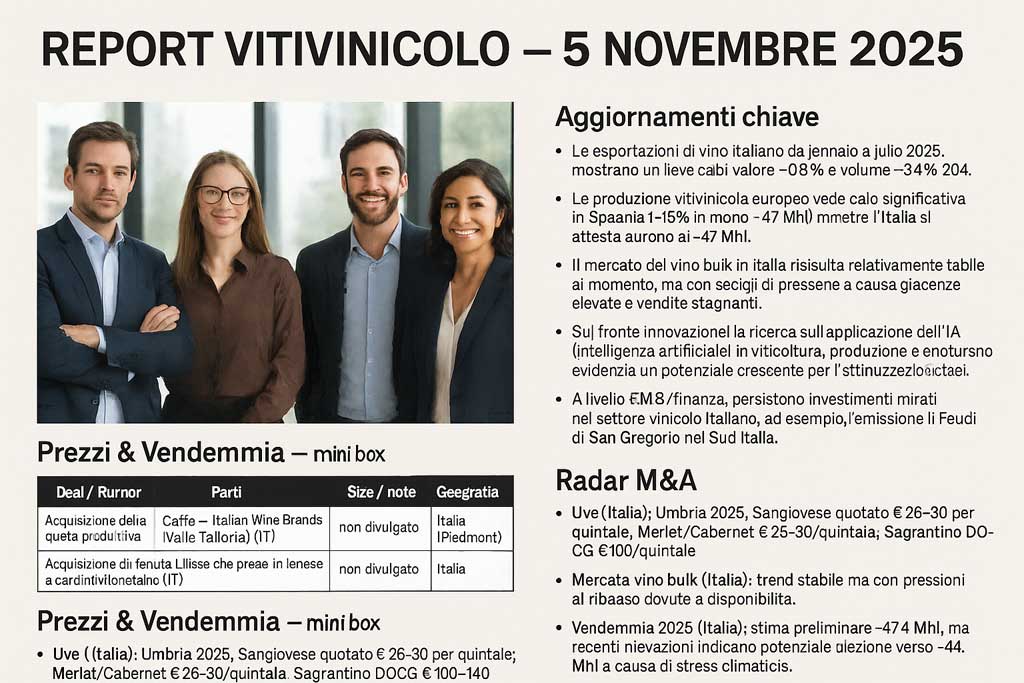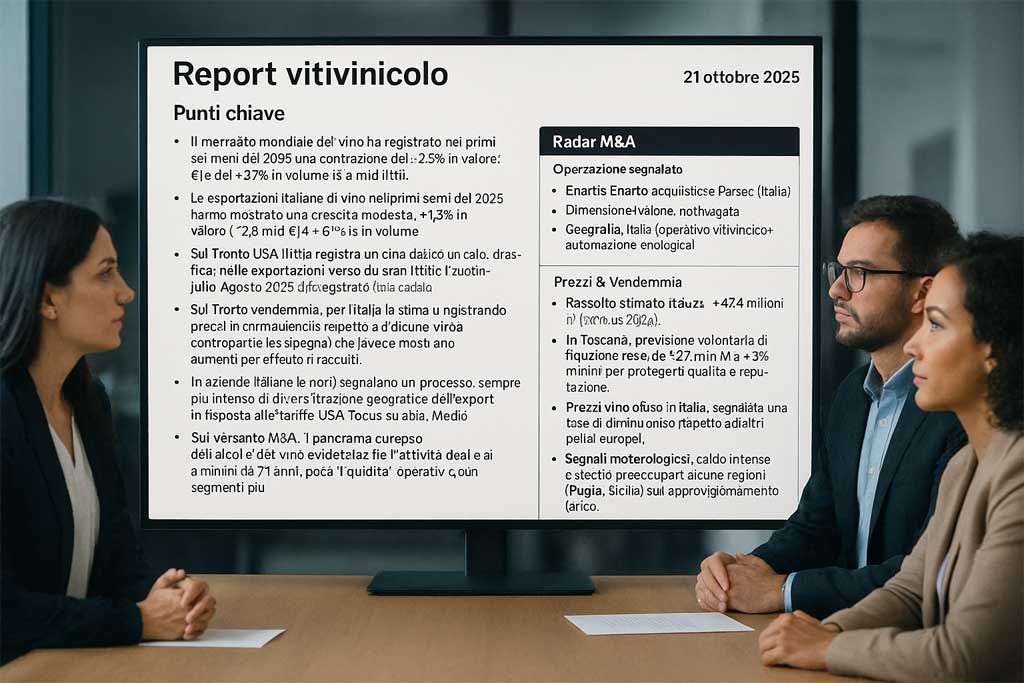News on Italian wine and oenology.
ITALIAN WINERIES
Conte Collalto Winery – Christmas as a Rite of Identity. The historic Conegliano-Valdobbiadene winery offers Manzoni Bianco and Vinciguerra for the holidays, wines that tell a tale of millennia-old roots and conviviality. The hills cultivated for over a thousand years by the Collalto family are once again the focus.
Cantine Ermes – Investments in Oltrepò and new “Oltrepo” line: Eight new tanks (40% capacity), the first line of seven wines dedicated to the region, and a confirmed growth path. President Rosario Di Maria speaks of strong synergies with producers and institutions following the acquisition of the Canneto Pavese winery.
Cantina Belpoggio – Twenty Years Celebrated in Montalcino At Benvenuto Brunello, the winery recounted two decades of history with “Decanting2Decades.” An immersive celebration between Castelnovo dell’Abate and the Abbey of Sant’Antimo, the ideal cradle of Sangiovese.
ERT1050 – The Classic Mountain Method according to Oniwines. A sustainable vertical viticulture project for Trentodoc Classic Method has been launched in Brentonico (Trentino). The winery is a “fortress” nestled in Monte Baldo.
Palazzo Lodron – Day 2 of the Advent Calendar Between Trento and Lake Garda, an elegant, handcrafted production takes shape, with award-winning wines and an underground cellar that showcases a four-century-old heritage.
La Sabbiona – Special Go Wine Award for its Famoso The Faenza winery wins the “Good… I didn’t know it!” award for its “VIP” Ravenna IGP Famoso, the fruit of a journey that began 18 years ago to relaunch this ancient grape variety.
ITALIAN WINE AND ITALIAN OENOLOGY
40 years since the methanol scandal. The scandal that changed Italian wine forever. Since late 1985, over 2.5 tons of methanol were discovered illegally used by multiple wineries: 23 deaths, 150 poisonings, and a turning point for regulations and the perception of quality.
Italian wine: between new frontiers and the sparkling wine boom. The Nomisma study describes a sector with 30,000 processing companies, a €16 billion turnover, and a key role in sparkling wines. Growing importance for exports and perceived quality.
Italy sells more wine to China. According to the Federvini Observatory, despite tariffs and global uncertainty, Italy is holding up better than its competitors. Its ability to adapt to new markets is growing, while France and Chile are experiencing more severe contractions.
Gangmastering in Agriculture – 2,500 “Shadowed” Workers in Friuli Venezia Giulia. The phenomenon of “landless self-employed workers” of Pakistani origin leads to unfair competition and exploitation. The regional observatory reports a 68% increase in two years.
INTERNATIONAL
Libby Brodie – The teetotaler consultant rewriting the rules of wine. An influential figure in the drinks industry, a technical taster and “Wine Translator,” she aims to democratize wine by eliminating snobbery. Seemingly paradoxical: she’s teetotal.
France looks to Italy for promotion Jérôme Bauer (Cnaoc) points to the Italian model as a reference: Italy invests 100 million/year in promotion, France only 40. A unitary “Wine of France” project has been called for.
The wine crisis in France: tariffs, climate, 70-year low harvests, war in Ukraine, and plummeting sales in China. Thousands of winemakers take to the streets demanding a bailout.
The renaissance of natural wines in Turkey. Thanks to the work of Sabiha Apaydin, Turkey (the world’s fifth-largest grape producer) is reshaping its identity with native grape varieties and natural wines. The “Kök, Köken, Toprak” symposium is becoming an international reference.
WINE EVENTS
Open Cellars at Christmas 2025 – Wine tourism celebrates December. A national event of the Wine Tourism Movement: tastings, illuminated villages, and a green approach thanks to the collaboration with Earth Day Italy.
Go Wine – Presentation of “Cantine d’Italia 2026” 911 wineries selected, 270 Impronte d’Eccellenza (Imprints of Excellence), 5,180 wines nominated. Focus on hospitality, wine culture, company museums, and storytelling.
Cantine d’Italia recognizes Brescia’s wine tourism. Franciacorta and Garda confirm their position as cutting-edge hubs. Bellavista is among the 25 wineries awarded the Tre Impronte (Three Fingerprints) award.
Michelin – The “Wine Selection” and “Grappoli” system are launched. “Michelin Grapes” are now available, with scores ranging from 1 to 3 based on agronomic quality, technique, identity, balance, and consistency. France leads the way (Burgundy and Bordeaux), while Italy is expected to join in 2026.
Civitas Vini – Cori celebrates history and cellars A new widespread event is born on December 7th and 8th: museums, cellars and art dialogue in an experiential journey dedicated to the Cori DOC.
The Wine & Spirits Vintage Auction – December 11 in Milan: Wannenes is auctioning 585 lots from three prestigious collections, including Giorgio Manenti’s historic cellar. A tasting of rare labels is also scheduled.
Sicily’s Wine Region – The 2026 Guide Presented. Il Giornale di Sicilia and Slow Wine present a mosaic of excellence, from large wineries to small family-run businesses.
Italian City of Wine 2026–27: Vulture Conegliano-Valdobbiadene doubles its title. For the first time, two regions share the title, uniting Basilicata and Veneto in a two-year program of wine tourism and cultural initiatives.
2025 Rome Wine Award – Calabria on the podium The 2024 Terre di Gerace Bianco (Barone Macrì) takes second place among white wines made from native vines in the national selection.
EXTRA / SOCIETY
Nduja, wine, and lobbying at the Chamber of Deputies – The “Calabrese ceremony” A political tasting featuring Pecorino Reggino and Greco Nero cheeses, organized by MP Domenico Furgiuele. Guests included parliamentarians, managers, and the inevitable presence of the President of the Republic.
Thanks for listening: today’s press review is brought to you by WINEIDEA.IT . Tomorrow, a new look at the wine landscape, always keeping our compass focused on the essential: reading the signs before they become evident.





